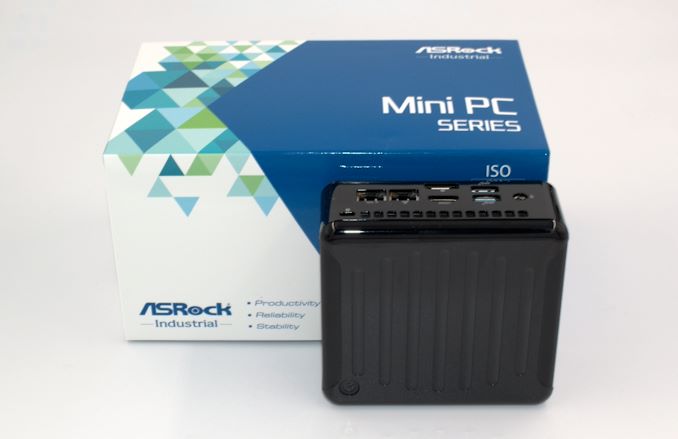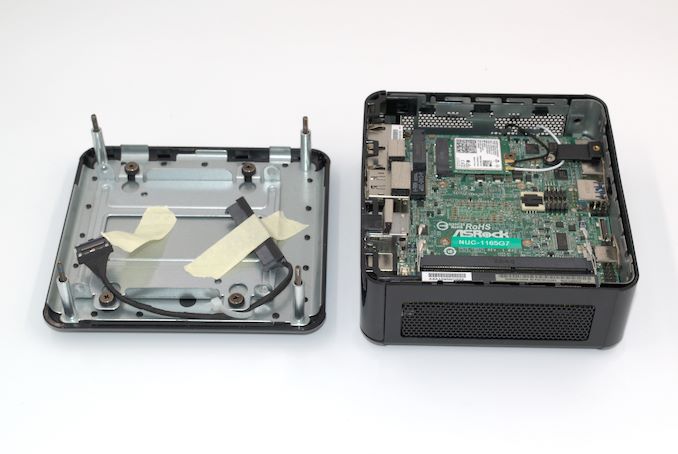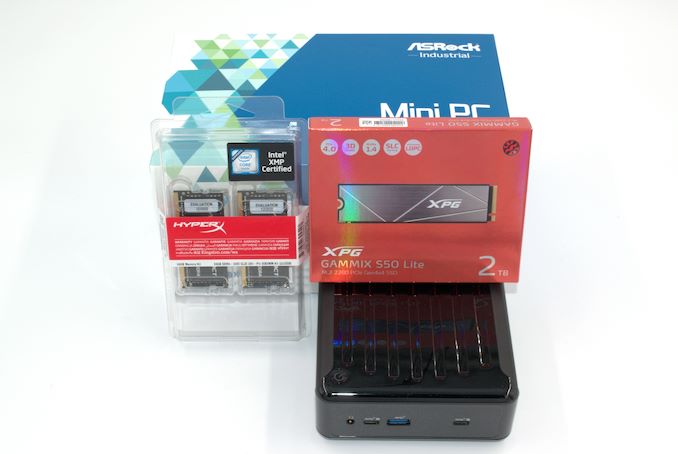ASRock Industrial NUC BOX-1165G7 Mini-PC Review: An Ultra-Compact Tiger Lake Desktop
by Ganesh T S on August 26, 2021 8:15 AM EST- Posted in
- Systems
- Intel
- NUC
- UCFF
- Willow Cove
- ASRock Industrial
- Tiger Lake-U

Intel introduced the Willow Cove micro-architecture with their Tiger Lake processors in the second half of 2020. These were designed to span a wide range of performance levels and applications, with TDPs ranging from as low as 7W up to 65W.
While mobile systems are the prime market for the 7W - 15W SKUs, higher TDP processors have found themselves in a number of different form-factors ranging from notebooks and UCFF mini-PCs to full-blown gaming desktops. Many ultra-compact mini-PCs based on Tiger Lake have been introduced by different vendors in the last few quarters, but challenges in the global semiconductor supply chain have resulted in scarce supply. ASRock Industrial was one of the first to announce a 'NUC' based on Tiger Lake - the 1100 BOX series. Introduced in October 2020, it started appearing in the channel in early 2021.
We have already seen the capabilities of Tiger Lake in a gaming desktop (Beast Canyon NUC). In that system, Tiger Lake appeared in a 8C/16T 65W TDP avatar. Developments related to ultra-compact form-factor (UCFF) machines over the last decade have resulted in systems that are able to successfully handle 28W TDP processors, and that has become the de-facto standard for high-performance UCFF PCs. ASRock Industrial's NUC 1100 BOX series has three SKUs, all of which are based on 28W TDP Tiger Lake-U processors. The flagship SKU is the NUC BOX-1165G7 based on the Intel Core i7-1165G7.
Competitively speaking, the Tiger Lake UCFF PCs come in at a time when systems based on AMD's compelling 7nm Zen 2-based Ryzen 4000U series of processors are already well-established in the market. Advancements in power efficiency and performance per watt, along with a slew of platform updates had enabled Zen 2-based mini-PCs to present a credible challenge to Comet Lake-based systems in terms of value proposition. Can Tiger Lake shift the metric back towards Intel? This review takes a look at the features and capabilities of the NUC BOX-1165G7, with some commentary on what Tiger Lake brings to the table for machines in this form-factor.
Introduction and Product Impressions
ASRock is a well-known vendor in the consumer PC market. In 2011, the company set up the ASRock Industrial business unit to focus on industrial motherboards. The division branched out in 2018 as an independent vendor with exclusive focus on B2B products. The company has products for deployment in small businesses (offices), automation, robotics, security, and other industrial / IoT applications.
Primarily, the company develops motherboards, and sells them to various system integrators who can do their own value additions. For example, OnLogic's ML100G-40 is based on ASRock Industrial's 4X4-V1000M AMD Ryzen Embedded motherboard. As we saw in our review of the ASRock Industrial 4X4 BOX-V1000M and the 4X4 BOX-4800U, the company also sells mini-PCs based on the developed motherboards into the retail channel. The motherboard enclosure bears a strong resemblance to ASRock's Beebox series. ASRock has not updated the Beebox since the introduction of Kaby Lake, possibly not wanting to step into ASRock Industrial's BOX series of UCFF PCs.
ASRock Industrial has two distinct actively-cooled UCFF PC lineups - the NUC BOX series based on Intel's processors, and the 4X4 BOX series based on AMD Ryzen. Using processors configured with TDPs up to 28W, these clones of the Intel's mainstream NUCs service a wide range of applications. The NUC 1100 series of Tiger Lake-U motherboards comes in three different versions, as we outlined in our coverage of the introduction of the lineup last year.
The NUC-1165G7 places the 4.09" x 4.02" (103.9 mm x 102.1 mm) motherboard inside a chassis measuring 110 mm x 117.5 mm x 47.85 mm. The height allows ASRock Industrial to integrate support for a 2.5" SATA drive, should the end user require installation of one. With its B2B focus, and need for the system to service embedded and industrial applications, the company also integrates a watchdog timer and hardware TPM (from Infineon) on the motherboard. The soldered processor (Intel Core i7-1165G7) has four cores with hyperthreading enabled. It can operate with a TDP configurable between 12W and 28W, with ASRock Industrial setting it to 28W in the NUC BOX-1165G7.
Our review sample was barebones, similar to the system currently being sold in the channel. We configured it with 64GB of Kingston's HyperX Impact DD4 SODIMMs (now, Kingston Fury) and ADATA's entry-level low-power PCIe 4.0 SSD - the XPG GAMMIX S50 Lite.
The specifications of our ASRock Industrial NUC BOX-1165G7 review configuration are summarized in the table below.
| ASRock NUC BOX-1165G7 Specifications | |
| Processor | Intel Core i7-1165G7 Tiger Lake-U 4C/8T, 2.8 - 4.7 GHz Intel 10nm, 12 MB L2, 12 - 28 W (28W) --- |
| Memory | Kingston HyperX Impact KHX3200C20S4/32GX DDR4-3200 SODIMM 20-22-22-48 @ 3200 MHz 2x32 GB |
| Graphics | Intel Iris Xe Graphics (96EU) |
| Disk Drive(s) | ADATA XPG GAMMIX S50 Lite (2 TB; M.2 Type 2280 PCIe 4.0 x4 NVMe; Micron 96L 3D TLC) (Silicon Motion SM2267 Controller) |
| Networking | Intel Wi-Fi 6 AX200 1 × GbE port (Intel I219-V) 1 × 2.5 GbE port (Intel I225-LM) |
| Audio | 3.5mm Headphone Jack (Realtek ALC233) Capable of 5.1/7.1 digital output with HD audio bitstreaming (HDMI / DP) |
| Miscellaneous I/O Ports | 2x USB 3.2 Gen 2 Type-A (rear) 1x USB 3.2 Gen 2 Type-A (front) 1x Thunderbolt 4 Type-C (front) 1x USB 3.2 Gen 2 Type-C (front) |
| Operating System | Retail unit is barebones, but we installed Windows 10 Enterprise x64 |
| Pricing | $583 (barebones) $1073 (as configured / No OS) |
| Full Specifications | NUC BOX-1165G7 Specifications |
The ASRock NUC BOX-1165G7 kit doesn't come with any pre-installed OS. Necessary drivers can be downloaded off ASRock Industrial's product support page. In addition to the main unit, the other components of the package include a 90 W (19V @ 4.7A) adapter, a US power cord, a VESA mount (along with the necessary screws), two M.2 screws, and a quick-start guide.
The various chassis features and internal motherboard layout can be gleaned from the two galleries below.






















33 Comments
View All Comments
sutramassage2 - Wednesday, September 1, 2021 - link
Our flair for showcasing koramangala ingredients shines through in every one of our menus, whether you are looking for a casual lunch or dinner at sutra massage & b2b spa, or a traditional Afternoon sandwich massage. for more info visit here:- https://www.sutramassage.commode_13h - Tuesday, September 21, 2021 - link
spammerwillis936 - Thursday, August 26, 2021 - link
This is a quite nice looking product. I just wish they'd have used a latching power connector.brunosalezze - Thursday, August 26, 2021 - link
I have one of these. Its actually my work pc right now, I dont need a gpu or multiple cores to code, I and have dedicated servers avaiable to run the code. It serves me very well to be able to have 2 4k monitors and not strugle to move the mouse. My only issue with it, its when I try to hook up a gpu with a R43SG. Its very hard to boot, the issue is not the conection, I've used this connector to other mini pcs with my 6800 and always worked very well, the issue is this particular bios, I think.xsoft7 - Thursday, August 26, 2021 - link
there is a Zen3 mini PC.. with 5900HX which costs 649$ can you review it?https://store.minisforum.com/collections/all-produ...
many youtube videos are raving about it.
abufrejoval - Thursday, August 26, 2021 - link
You send them one, they'll be more likely to review it.Now seriously, you can infer quite a bit on Ryzen by looking at what has been tested already.
All these APUs are basically the same silicon operated at distinct power settings, ~15 Watts for 5800U, ~35 Watts for 5900HX and ~65 Watts for 5700G.
The Vega9 graphics don't seem to benefit a terrible lot from extra Wattage, because it's mostly bandwidth constained. There are reviews out there which demonstrate the potential with overclocker DIMMs and an overclocked GPU, but those gains remain linear from a very low baseline.
Peak clocks are just a couple hundred MHz apart, hardly enough to matter, so what you mostly get from the extra Watts is sustained clocks on higher core counts. Go take the values for 15 Watts and 65 Watts, split the difference and add ~20% because CMOS won't give linear clock returns on Watts beyond say 2GHz.
Somewhere on Youtube you'll find someone raving about any thing. But APUs aim really for the very rational, just enough to get the work done in a couple of form factors and at a few price points.
meacupla - Thursday, August 26, 2021 - link
How would a 1135G7 (28W) compare with a Ryzen 5 PRO 5650GE (35W)?There are, or were, plenty of 1L class SFF PCs using the 4650GE, and OEMs are probably transitioning to the 5650GE right now.
If you are going to use a U series APUs at higher TDP, because it's a SFF, I think you might as well include 35W desktop APUs used in SFF for comparison.
abufrejoval - Thursday, August 26, 2021 - link
I got the NUC8 (Iris 655), NUC10 (UHD) and NUC11 (Xe) all as i7, each with 64GB and 10Gbit via Sabrent TB3 (Aquantia really) NICs to operate as a oVirt(RHV) HCI cluster.Played around with Windows a bit before they became "productive".
I was really interested to see how the iGPU generations would play out and in IPC vs cores, 14nm vs. 10nm etc.
Twice the iGPU resources (48 vs 24EU) + the 128MB eDRAM on the Iris 655 only got 50% performance increase, just as the 3DMark gaming score shows. That seemed to spell trouble for the 96EU Xe, which doesn't have any of that. But it didn't. Instead the 96EU Xe scales pretty much linearly vs the 24EU UHD, but that still doesn't make it a games engine. Still a NIght Raid or WildLife type game runs just fine at FHD on the NUC11.
In terms of CPU benchmarks, it was a clear win for the NUC11. It got awfully close to my 5800X on single core benchmarks, especially on Linux, while the 6-Core 10700U could not gain ground against the 4-Core 1065G7 on e.g. Blender or anything thready.
I also have a Lenovo 5800U notebook, which can be configured for the 28Watt and 15Watt energy consumption levels (which is sticks to, religiously!) and it really can't gain much ground on thready workloads against the 1065G7, either, when that is configured to those same 15 and 28 Watt limits. I only measured via HWinfo, not at the wall, so there is that.
What I really like about the NUCs is that they allow very precise control over P1, P2, TAU and the fans (I need absolute control over maximum noise and want max CPU for that in operation). They give you that, while the generation over generation looks of that BIOS are so different, it seams to be completely different teams.
Ah and yeah, the Xe graphics do outperform the Vega9 on the 5800U significantly in numbers, while it doesn't really matter for gaming. Both are super smooth with Google Maps in 3D mode on Chromium in Windows at 4k. But any software less optimized will struggle beyond 2D.
Multi-Monitor support on all the Intel iGPUs is excellent on Windows and Linux, the Vega9 has serious issues switching between external and internal graphics even on Windows. A dual alt-mode USB-C adapter which supports a 4k primary and a FHD secondary seamlessly on any Intel iGPU with very OS I've tested works as you'd expect it, but with the Radeon drivers (both Lenovo and latest AMD) just switching between the 3k laptop screen and the external 4k primary freezes the output to the point where only a hard poweroff will bring it back.
With all systems playing with the power settings (15-64Watts for the NUCs, 12-28Watts for 5800U), those settings did little to nothing for the iGPU. It's really just all about how much left-over budget goes to enable higher CPU clocks (until thermals kick in).
zsdersw - Friday, August 27, 2021 - link
What exactly is "industrial" about it? If it's not fanless it can't really be considered industrial and it's just another NUC-type computer.abufrejoval - Friday, August 27, 2021 - link
The marketing channel.They don't metion any testing specification in the technical data on the ASrock web site.
Without that it may just mean that consumer (fool protection) return rights might not apply.